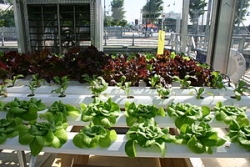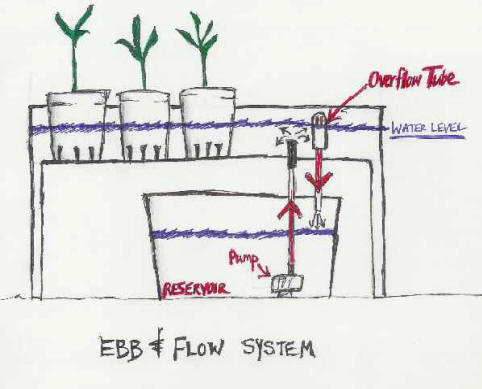The Urban Farmer, Issue #047 * Feed the World! * Ebb & Flow Basics *
Check pH
April,
2012:

Man’s heart away from
nature becomes hard.”
~Standing
Bear
Can
Hydroponics Feed the World?

One owner operated indoor farm is using both Hydroponics Systems as well as
Aquaponics to grow not only a variety of fresh produce for their community,
but also to bring fresh fish to the community of West Barnstable,
Massachusetts.
As one of the few indoor Aquaponic farms in the US, E&T Farms, run by Ed
Osmun and his wife Betty, are a popular supplier of salad greens, basil,
arugula and garlic for their community, selling their produce at local
farmers’ markets and natural foods stores.
Hydroponics Systems Using Aquaponics Nutrients
Their system is pretty typical for a large-scale indoor setup; one room,
kept fairly dark to inhibit algae growth, contains fish in tanks where they
remove contaminants and add nutrients to the water just by doing their
natural business, which is then cycled to the next –much brighter–
vegetation room, which contains their crops.
The fish that they are currently raising are koi and tilapia, though they
soon plan to replace the tilapia with more valuable sea creatures, like
freshwater prawns. The Osmun’s blame an influx of cheap, Asian-grown tilapia
for killing the market for these commonly-eaten fish.
To keep things natural, E&T Farms use no pesticides. Indoor systems are
famous for being less susceptible to pest infestations, but for added
protection, the Osmun’s employ a system known as “integrated pest
management” where they introduce beneficial insects like ladybugs into the
garden to eliminate the bad ones. This is an incredibly effective strategy
for both indoor and outdoor gardens, and leads to healthier, more delicious
fruits and vegetables.
Their work with insects doesn’t stop with ladybugs, either. As a side
project, the Osmun’s raise a colony of bees, which they transport to nearby
farms to help with pollenation. This is a very important service, because
wild bees seem to be disappearing at an alarming rate, and without bees crop
pollination is difficult. No crops equals no food.
EBB & FLOW BASICS

The ebb and flow (also called
flood and drain) is the classic hydroponic system. It is easy to
understand, build and maintain. It’s versatile and can accommodate pots of
any size, or even rockwool blocks. We love the ebb and flow and use it
often.
HERE’S HOW IT WORKS:
Individual potted plants are arranged on a
drain table or “growing bed” which can hold a few inches of water.
Periodically, nutrient solution is pumped in, flooding the holding bed. The
plants are watered from the bottom through the drain holes in the pots.
After a few minutes of soaking, the pump
cuts off, and the table drains, the nutrient returning to the reservoir
below it. This flood-and-drain cycle repeats 2-4 times a day. Simple but
very effective.
IMPORTANT OPERATING POINTS ABOUT
EBB & FLOW
*Keep the ph between 5.5- 6.5. Improper ph
can starve the plant and lead to leaf cannibalization. As the name implies,
leaf cannibalization occurs as the plant takes nutrients from one part of
the plant and uses those nutrients in a different part of the plant. Leaf
cannibalization appears as yellow or brown spots on leafs.
*During Flowering pH rises quite a bit each
day. Also, during Flower, nutrients and water absorption increases. This
causes ppms to increase significantly. Proper control requires routine
checking and replacing with fresh nutrients as needed.
*Since the plant is being fed several
times a day, lower ppm nutrients (600–800) are sufficient. Pushing with
higher ppms can cause the plant to burn up from the inside, especially when
significant water evaporation/usage causes the remaining nutrient
concentration to increase beyond 1500 ppms.
*Choosing a medium like lava rock is ideal
for flood and drain in that it drains quickly, and due to its rough texture,
it traps small amounts of oxygen and nutrients which keeps the root zone
moist between feedings.
*Poor drainage, or incomplete drainage, may
cause a condition wherein dense roots are exposed to stagnant water which is
trapped by the root mass. Root rot and fungal growth are the most common
result of stagnant water. Make sure you have good drainage by using medium
of adequate size and ensuring that drainage of the container between flood
cycles is complete.
*Hydrogen peroxide can be added to nutrient
solutions when there is suspicion that the anaerobic root rot mold has begun
to proliferate on the roots’ surfaces. Typically several tablespoons of 3.5%
solution per gallon or more of water are used. The temporary rise in the
oxygen level is only minimally damaging to roots, while eradicating the
water-borne mold can significantly increase yield or even save a crop’s
viability.
Hydro Tip of the Month-
When to test the ph
- When you mix up a new batch of grow juice. Let it settle for
a couple hours. Then test and adjust the pH. Let set an hour and test
the pH again…
- Twice a week thereafter. If you are a worrier, test your
hydroponic solution daily. It only costs a few drops of test solution.
We hope you have enjoyed this issue of The Urban Farmer Ezine. Each month, we will bring you another inspiring photo, gardening quote or idea, plus fresh new hydroponics news, techniques & products.
Insiders tips to get you growing…

~Stella and Simon from
Hydroponics-Simplified.
|


Reply